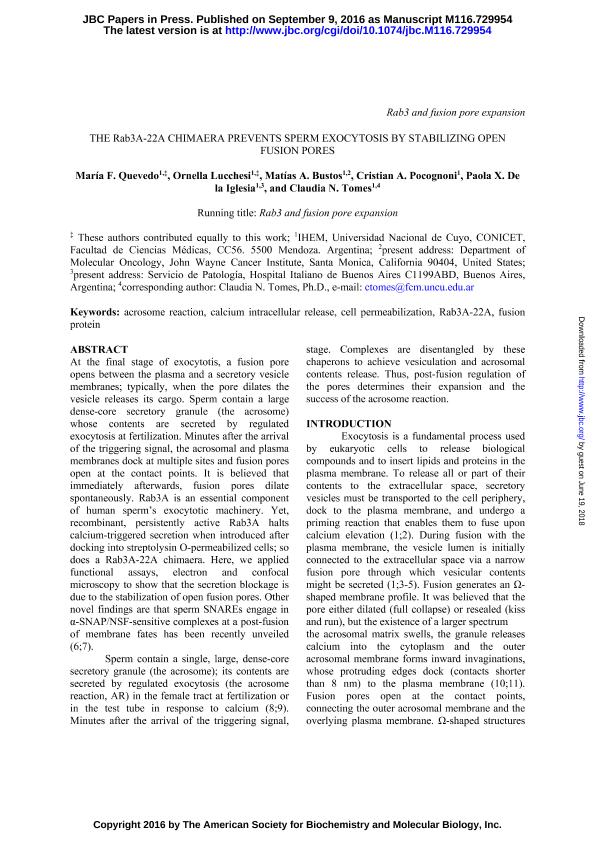Mostrar el registro sencillo del ítem
dc.contributor.author
Quevedo, María Florencia

dc.contributor.author
Lucchesi, Ornella

dc.contributor.author
Bustos, Matias Alberto

dc.contributor.author
Pocognoni, Cristián Adrián

dc.contributor.author
De la Iglesia, Paola X.
dc.contributor.author
Tomes, Claudia Nora

dc.date.available
2018-06-19T18:56:12Z
dc.date.issued
2016-10
dc.identifier.citation
Quevedo, María Florencia; Lucchesi, Ornella; Bustos, Matias Alberto; Pocognoni, Cristián Adrián; De la Iglesia, Paola X.; et al.; The rab3A-22A chimera prevents sperm exocytosis by stabilizing open fusion pores; American Society for Biochemistry and Molecular Biology; Journal of Biological Chemistry (online); 291; 44; 10-2016; 23101-23111
dc.identifier.issn
1083-351X
dc.identifier.uri
http://hdl.handle.net/11336/49385
dc.description.abstract
At the final stage of exocytotis, a fusion pore opens between the plasma and a secretory vesicle membranes; typically, when the pore dilates the vesicle releases its cargo. Sperm contain a large dense-core secretory granule (the acrosome) whose contents are secreted by regulated exocytosis at fertilization. Minutes after the arrival of the triggering signal, the acrosomal and plasma membranes dock at multiple sites and fusion pores open at the contact points. It is believed that immediately afterward, fusion pores dilate spontaneously. Rab3A is an essential component of human sperm exocytotic machinery. Yet, recombinant, persistently active Rab3A halts calcium-triggered secretion when introduced after docking into streptolysin O-permeabilized cells; so does a Rab3A-22A chimera. Here, we applied functional assays, electron and confocal microscopy to show that the secretion blockage is due to the stabilization of open fusion pores. Other novel findings are that sperm SNAREs engage in α-SNAP/NSF-sensitive complexes at a post-fusion stage. Complexes are disentangled by these chaperons to achieve vesiculation and acrosomal contents release. Thus, post-fusion regulation of the pores determines their expansion and the success of the acrosome reaction.
dc.format
application/pdf
dc.language.iso
eng
dc.publisher
American Society for Biochemistry and Molecular Biology
dc.rights
info:eu-repo/semantics/openAccess
dc.rights.uri
https://creativecommons.org/licenses/by-nc-sa/2.5/ar/
dc.subject
Acrosome Reaction
dc.subject
Rab3a
dc.subject
Fusion Pore
dc.subject
Neurotoxin
dc.subject.classification
Otras Ciencias Biológicas

dc.subject.classification
Ciencias Biológicas

dc.subject.classification
CIENCIAS NATURALES Y EXACTAS

dc.title
The rab3A-22A chimera prevents sperm exocytosis by stabilizing open fusion pores
dc.type
info:eu-repo/semantics/article
dc.type
info:ar-repo/semantics/artículo
dc.type
info:eu-repo/semantics/publishedVersion
dc.date.updated
2018-06-13T16:53:44Z
dc.journal.volume
291
dc.journal.number
44
dc.journal.pagination
23101-23111
dc.journal.pais
Estados Unidos

dc.journal.ciudad
Bethesda
dc.description.fil
Fil: Quevedo, María Florencia. Consejo Nacional de Investigaciones Científicas y Técnicas. Centro Científico Tecnológico Conicet - Mendoza. Instituto de Histología y Embriología de Mendoza Dr. Mario H. Burgos. Universidad Nacional de Cuyo. Facultad de Cienicas Médicas. Instituto de Histología y Embriología de Mendoza Dr. Mario H. Burgos; Argentina
dc.description.fil
Fil: Lucchesi, Ornella. Consejo Nacional de Investigaciones Científicas y Técnicas. Centro Científico Tecnológico Conicet - Mendoza. Instituto de Histología y Embriología de Mendoza Dr. Mario H. Burgos. Universidad Nacional de Cuyo. Facultad de Cienicas Médicas. Instituto de Histología y Embriología de Mendoza Dr. Mario H. Burgos; Argentina
dc.description.fil
Fil: Bustos, Matias Alberto. John Wayne Cancer Institute; Estados Unidos. Consejo Nacional de Investigaciones Científicas y Técnicas. Centro Científico Tecnológico Conicet - Mendoza. Instituto de Histología y Embriología de Mendoza Dr. Mario H. Burgos. Universidad Nacional de Cuyo. Facultad de Cienicas Médicas. Instituto de Histología y Embriología de Mendoza Dr. Mario H. Burgos; Argentina
dc.description.fil
Fil: Pocognoni, Cristián Adrián. Consejo Nacional de Investigaciones Científicas y Técnicas. Centro Científico Tecnológico Conicet - Mendoza. Instituto de Histología y Embriología de Mendoza Dr. Mario H. Burgos. Universidad Nacional de Cuyo. Facultad de Cienicas Médicas. Instituto de Histología y Embriología de Mendoza Dr. Mario H. Burgos; Argentina
dc.description.fil
Fil: De la Iglesia, Paola X.. Hospital Italiano; Argentina
dc.description.fil
Fil: Tomes, Claudia Nora. Consejo Nacional de Investigaciones Científicas y Técnicas. Centro Científico Tecnológico Conicet - Mendoza. Instituto de Histología y Embriología de Mendoza Dr. Mario H. Burgos. Universidad Nacional de Cuyo. Facultad de Cienicas Médicas. Instituto de Histología y Embriología de Mendoza Dr. Mario H. Burgos; Argentina
dc.journal.title
Journal of Biological Chemistry (online)

dc.relation.alternativeid
info:eu-repo/semantics/altIdentifier/url/http://www.jbc.org/content/291/44/23101
dc.relation.alternativeid
info:eu-repo/semantics/altIdentifier/doi/http://dx.doi.org/10.1074/jbc.M116.729954
Archivos asociados
